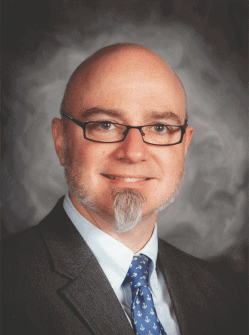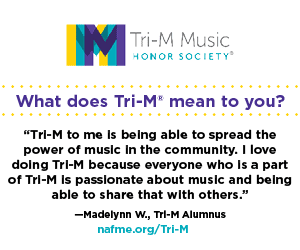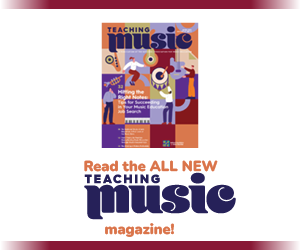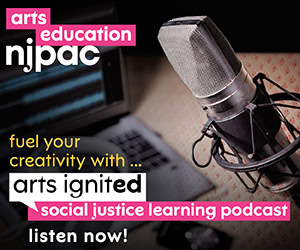/ News Posts / Guitar Class in the Mount Rushmore State
Guitar Class in the Mount Rushmore State
Number 46: The State of South Dakota
By Thomas Amoriello Jr.
NAfME Council for Guitar Education Chair
In this edition of “50 States of Guitar Class,” the NAfME Council for Guitar Education visits Sioux Falls Lutheran School in Sioux Falls, South Dakota. Karen Dooley is a music educator who incorporates the guitar into the overall music program for her students and encourages practical applications of the instrument for lifelong learning.
The NAfME Council for Guitar Education would like to thank Ms. Dooley for sharing her knowledge with the NAfME membership.
Please tell us about your school and overall music program.
I teach music at Sioux Falls Lutheran School in Sioux Falls, South Dakota. We are a private school supported by an association of Lutheran churches in our city and many wonderful families! We serve students in preschool through middle school. Our enrollment in K–8 is about 165 students, and our preschool enrollment is also about 175.
Our vibrant music program offers General Music instruction starting in preschool and continuing through 8th grade. Every student receives small group violin instruction beginning in kindergarten. We have choirs for grades 1–3, 4–5, and 6–8, a Beginning Band, an Advanced Band, and an option for grades 7–8 to join Marching Band. We also offer Tone Chimes Ensembles for grades 4–8, Orchestra for Grades 4–8, Guitar Ensemble for Grades 6–8, and optional opportunities for private lessons in piano, voice, band, and string instruments. All students in grades 6–8 are required to participate in at least one of our performing ensembles, but most students choose to participate in more than one ensemble.
Please tell us about your own personal musical background growing up and your collegiate experience.
I grew up on a farm in Southwestern Minnesota and spent countless hours at the piano. When I was 10 years old, I was fortunate to begin lessons with Mrs. Frances Almjeld, who was such a great piano teacher. She made sure I had a thorough knowledge of theory, classical music, duet playing, counting, ear training, sight-reading, chording; really just about everything—she gave me such a solid foundation.
I practiced a lot, sometimes just because I was bored at home. When I was in 7th or 8th grade, I thought about quitting lessons. I probably thought I knew enough by then. Ha! Little did I know, as I got into high school the best was yet to come! Chopin and Bach and all the classical literature definitely kept me challenged. I didn’t grow up hearing much classical music, and we didn’t even have a phonograph in my house but like many teenagers, I wanted to play popular songs that I’d heard on the radio. I was always able to play by ear and started writing my own arrangements of songs and bought books of pop music that my teacher would occasionally help me learn, but classical music was her priority, and I am thankful for that foundation. My younger sister bought a guitar when I was 17, and I persuaded her to let me use it so I could take some lessons at a music store. Again, I practiced a lot and really enjoyed all I was able to learn in that year before I went to college. Those lessons proved to be a real advantage years later when I found myself wanting to teach guitar.
In 1981 I enrolled at Southwest Minnesota State University in Marshall, Minnesota, to major in music education. Piano was my major instrument, and I was planning to get my degree in vocal music, although I was much more comfortable accompanying than singing. The head of the music department had the wisdom and foresight to encourage me to get my instrumental degree as well, as he felt I would be more employable since in our area of small towns, one teacher was often hired to teach both band and choir. I had never even played a band instrument until I got to college. I expressed my interest in saxophone, but they needed a bassoon player! I hardly even knew what a bassoon sounded like before that! Well, again, I had a great teacher, and tried to catch up quickly and took all the methods classes that were required for brass and winds, and percussion and strings, so that I could get my endorsement to teach instrumental music. But guitar? No. Nothing was required or offered as an option for guitar.
I remember teaching a beginning guitar community education class for adults sometime near the end of college, and we had such a fun time. The lessons I had back when I was 17 gave me the confidence to get started. Looking back, I was still such a beginner myself. I’ve always had a passion for teaching, so as long as I knew more than someone else, I enjoyed teaching what I could. I’m not sure if requirements have changed since I was in college, but I do think a guitar class for music education majors should be a requirement. After I graduated from college, I mostly taught private piano lessons for quite a few years and then eventually started teaching in school where I did indeed need to teach both vocal and instrumental music.
How do the guitar family of instruments fit into your teaching?
So far, I have only incorporated acoustic, electric, and bass guitars into my classes. I have considered adding ukuleles but have not done so yet.
What obstacles did you face when you were first hired at your school?
Up until I was hired, the classroom teachers were teaching their own music classes, so I had both the privilege and challenge of envisioning a complete music program. I had the most supportive school board and parents to really help me along! They were an incredible blessing!
Now?
Now the obstacle is learning how to manage the time in the schedule. Finding time for all of our ensembles to rehearse more than once a week is a challenge.
“I personally feel that it should be as much of a priority as teaching the recorder. The guitar is such a practical instrument that can be enjoyed for a lifetime!”
What kind of classes related to the guitar do you teach?
In my 6th grade general music class I teach “Introduction to the Guitar” where we learn chords, tab, some note reading, bass, and a little composition. I also teach or oversee the guitar ensemble class for 6–8th graders. This group includes a keyboard player and drummer and sometimes other instrumentalists or vocalists, and we rehearse and perform mostly praise and worship songs.
What would you like to say to the non-guitarist music educator who is about to or interested in incorporating the guitar into their program?
Definitely enroll in the Summer Workshop for guitar conducted by GAMA and NAfME. In all of my years of teaching and attending workshops, this one is tops! A MUST for those of us who do not claim guitar as our major instrument. If you can take a few private lessons, I’m sure that would also be a benefit.
And then, just go for it! Keep it simple and fun. You can do lots of things with 3–6 chords, even if you learn right along with your class. The kids will LOVE the opportunity to get their hands on a guitar. Also, I would advise purchasing guitars with nylon strings as they are more comfortable for kids (and teachers) who don’t have calloused fingertips! And invest in the little clip on tuners!
Do you have any success stories you would like to share about students (musical and non-musical)?
I believe all of my 6th graders have benefitted in some way from their experience with guitar, but one class especially sticks in my mind. I had a few students in that class who were not very motivated to put effort into academics or sports or even music classes. Students like this were one reason I was motivated to start offering guitar, as I just knew they needed something different than the typical band or choir options. Playing guitar proved to be a great outlet for them! They found success and became leaders in guitar ensemble. They were finally recognized for something positive! Fortunately, their parents got them electric guitars and lessons beyond what I could do. One of them started to write a lot of his own music and continued to do so through high school and beyond.
They may have discovered guitar eventually on their own, but the fact that they could literally “rock” at least one class at school made a huge difference and three or four of them started to form a little band, giving them that sense of community and belonging that everyone needs.
Also, recently I had a smaller class that loved improvising together. One of the guys was kind of a natural who could play by ear and enjoyed playing the electric guitar. After we studied the blues, everyone found a way to pick up an instrument and get involved! One guy played the drum set, one took the bass, a couple of kids had fun adding tambourine, cowbell, keyboard, and other instruments. They got pretty good at working together which didn’t often happen for this class in other areas.
“One of my goals is to help every student to be able to find their niche in music. Playing guitar is the perfect option for many of them who don’t choose band or orchestra or choir.”
One of my goals is to help every student to be able to find their niche in music. Playing guitar is the perfect option for many of them who don’t choose band or orchestra or choir. Also, one of the greatest successes is to see how music ensembles of any type can bring people together and create a common bond and a place to belong. That is something that is really needed in our world right now!
What do you tell your talented students who are planning to pursue music or guitar studies in high school or college after they finish with you?
PLEASE go on to study with someone who has more skill and knowledge than I do! Keep playing!!! There is so much more to discover. The best is yet to come!
Do you have any networking or advocacy tools that have worked for you promoting your program that would help other educators?
Try to give guitar as much attention as you would give band, orchestra, choir, or whatever else you are offering. Get your kids performing as often as you can—take them to give concerts for the senior citizen communities or the kindergarten class or anywhere that you can bring a smile to someone!
What kind of future do you see for guitar in music education in South Dakota schools?
I think the future is bright! South Dakota hosted their first GAMA/NAfME Summer Guitar Workshop in Mitchell, South Dakota, last year, and hopefully that will continue and more and more teachers will bring guitar instruction into their classrooms. I personally feel that it should be as much of a priority as teaching the recorder. The guitar is such a practical instrument that can be enjoyed for a lifetime!
What type of lesson plans have you done for your classes that may be unique?
I teach a lot of praise and worship songs, so it’s a bit of a challenge to continue to keep up with the newest, most relevant songs, but it is worth it and is so practical for those who may find their way to a music worship team at their church.
Do you do any musical performances or activities outside of your public school teaching duties?
I am an organist at my church.
Any last thoughts to conclude our interview?
Feel free to reach out to me if you think I can be of any help! Thank you for the opportunity to share my thoughts and experiences.
Read more “Guitar Class in 50 States” articles:
- Number 50: The Granite State (New Hampshire)
- Number 49: The Green Mountain State (Vermont)
- Number 48: The Mountain State (West Virginia)
- Number 47: The Hoosier State (Indiana)
- Number 45: The Pine Tree State (Maine)
- Number 44: The Badger State (Wisconsin)
- Number 43: The Constitution State (Connecticut)
- Number 42: The Evergreen State (Washington)
- Number 41: The Pelican State (Louisiana)
- Number 40: The Beaver State (Oregon)
- Number 39: The Equality State (Wyoming)
- Number 38: The Empire State (New York)
- Number 37: The Old Line State (Maryland)
- Number 36: The Centennial State (Colorado)
- Number 35: The Bay State (Massachusetts)
- Number 34: The Sooner State (Oklahoma)
- Number 33: The Prairie State (Illinois)
- Number 32: The Hawkeye State (Iowa)
- Number 31: The Volunteer State (Tennessee)
- Number 30: The Palmetto State (South Carolina)
- Number 29: The Natural State (Arkansas)
- Number 28: The Tar Heel State (North Carolina)
- Number 27: The Magnolia State (Mississippi)
- Number 26: The Peace Garden State (North Dakota)
- Number 25: The Treasure State (Montana)
- Number 24: The First State (Delaware)
- Number 23: The Buckeye State (Ohio)
- Number 22: The Yellowhammer State (Alabama)
- Number 21: The Sunflower State (Kansas)
- Number 20: The Great Lakes State (Michigan)
- Number 19: The Lone Star State (Texas)
- Number 18: The Bluegrass State (Kentucky)
- Number 17: The Golden State (California)
- Number 16: The Show-Me State (Missouri)
- Number 15: The Keystone State (Pennsylvania)
- Number 14: The Last Frontier State (Alaska)
- Number 13: The Beehive State (Utah)
- Number 12: The Peach State (Georgia)
- Number 11: The Cornhusker State (Nebraska)
- Number 10: The Gem State (Idaho)
- Number 9: The Old Dominion (Virginia)
- Number 8: The Aloha State (Hawaii)
- Number 7: The Land of Enchantment (New Mexico)
- Number 6: The Sunshine State (Florida)
- Number 5: The Grand Canyon State (Arizona)
- Number 4: The Ocean State (Rhode Island)
- Number 3: The North Star State (Minnesota)
- Number 2: The Silver State (Nevada)
- Number 1: The Garden State (New Jersey)
About the author:
 Thomas Amoriello Jr. serves as the chair on the NAfME Council for Guitar Education and is also the former Chairperson for the New Jersey Music Education Association. Tom has taught guitar classes for the Flemington Raritan School District in Flemington, New Jersey, since 2005 and was also an adjunct guitar instructor at Cumberland County College, New Jersey, for five years. He has earned a Master of Music Degree in Classical Guitar Performance from Shenandoah Conservatory and a Bachelor of Arts in Music from Rowan University. He is the author of the children’s picture books A Journey to Guitarland with Maestro Armadillo and Ukulele Sam Strums in the Sand, both available from Black Rose Writing. He recently made a heavy metal recording with a stellar roster of musicians including former members of Black Sabbath, Whitesnake, Ozzy Osbourne, Yngwie J. Malmsteen’s Rising Force, and Dio that was released on H42 Records of Hamburg, Germany. The record released on 12-inch vinyl and digital platforms has received favorable reviews in many European rock magazines and appeared on the 2018 Top 15 Metal Albums list by Los Angeles KNAC Radio (Contributor Dr. Metal). Visit thomasamoriello.com for more information.
Thomas Amoriello Jr. serves as the chair on the NAfME Council for Guitar Education and is also the former Chairperson for the New Jersey Music Education Association. Tom has taught guitar classes for the Flemington Raritan School District in Flemington, New Jersey, since 2005 and was also an adjunct guitar instructor at Cumberland County College, New Jersey, for five years. He has earned a Master of Music Degree in Classical Guitar Performance from Shenandoah Conservatory and a Bachelor of Arts in Music from Rowan University. He is the author of the children’s picture books A Journey to Guitarland with Maestro Armadillo and Ukulele Sam Strums in the Sand, both available from Black Rose Writing. He recently made a heavy metal recording with a stellar roster of musicians including former members of Black Sabbath, Whitesnake, Ozzy Osbourne, Yngwie J. Malmsteen’s Rising Force, and Dio that was released on H42 Records of Hamburg, Germany. The record released on 12-inch vinyl and digital platforms has received favorable reviews in many European rock magazines and appeared on the 2018 Top 15 Metal Albums list by Los Angeles KNAC Radio (Contributor Dr. Metal). Visit thomasamoriello.com for more information.
Interested in reprinting this article? Please review the reprint guidelines.
The National Association for Music Education (NAfME) provides a number of forums for the sharing of information and opinion, including blogs and postings on our website, articles and columns in our magazines and journals, and postings to our Amplify member portal. Unless specifically noted, the views expressed in these media do not necessarily represent the policy or views of the Association, its officers, or its employees.
Catherina Hurlburt, Marketing Communications Manager. April 30, 2020. © National Association for Music Education (NAfME.org)
Published Date
April 30, 2020
Category
- Ensembles
Copyright
April 30, 2020. © National Association for Music Education (NAfME.org)







